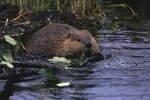
The bighorn sheep (Ovis canadensis) is a mountain sheep notable for the males' immense, prominent and dense horns. These horns can grow to more than 30 inches long. Female bighorns also have horns, usually 8 to 10 inches long. Male bighorn sheep are referred to as rams, and the females are called ewes.
Information on the Bighorn Sheep
These generally diurnal ungulates are grazing animals who eat grass and a lot of broad-leaved herbaceous plants such as phlox, cinqefoil and clover. Grass-wise, bighorn sheep tend to gravitate toward wheatgrass, fescues and bluegrass among others. Those in arid desert environments also eat a lot of cactus and holly. Foliage, shoots and twigs also make up their basic diet. Bighorn sheep generally weigh between 140 and 300 pounds, according to the Defenders of Wildlife organization. They usually are deep brown, lighter brown or gray.
Geography of the Bighorn Sheep
These sturdy sheep are native to the United States, Canada and Mexico. They are especially common in northern Mexico and in western Canada and the western United States. They do not appear outside of North America. States that have bighorn sheep include Idaho, Utah, California, New Mexico and Nevada.
Habitat of the Bighorn Sheep
The natural habitat of these herbivorous mammals includes foothills, alpine meadows and slopes of mountains that have ample grass. Bighorn sheep do well in especially steep areas, as the tiny ledges often make for effective escapes against the species' biggest predators, such as bears, bobcats, mountain lions and coyotes. Bighorn sheep are typically drawn to locations near bluffs and rough, uneven-surfaced cliffs.
Risks to the Bighorn Sheep Population
Bighorn sheep are not an endangered species, according to the Red List of Threatened Species from the International Union for Conservation of Nature. They are part of the "least concern" department because of their stable, under-control populations. However, potential risks include poaching. In Mexico, problems include damage to bighorns' habitat and competition with livestock over sustenance.
References
- National Park Service: Bighorn Sheep
- Colorado Parks & Wildlife: Bighorn Sheep
- Defenders of Wildlife: Basic Facts About Bighorn Sheep
- NatureWorks: Bighorn Sheep
- University of Michigan Animal Diversity Web: Ovis Canadensis
- International Union for Conservation of Nature Red List: Ovis Canadensis
- Bighorn Institute: Facts About Bighorn Sheep
- National Wildlife Federation: Bighorn Sheep
Photo Credits
-
Stockbyte/Stockbyte/Getty Images



